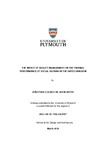THE IMPACT OF QUALITY MANAGEMENT ON THE THERMAL PERFORMANCE OF SOCIAL HOUSING IN THE UNITED KINGDOM
| dc.contributor.supervisor | de Wilde, Pieter | |
| dc.contributor.author | ULRICH DE ALENCASTRO, JOÃO PAULO | |
| dc.contributor.other | School of Art, Design and Architecture | en_US |
| dc.date.accessioned | 2019-08-05T11:39:56Z | |
| dc.date.available | 2019-08-05T11:39:56Z | |
| dc.date.issued | 2019 | |
| dc.identifier | 10511915 | en_US |
| dc.identifier.uri | http://hdl.handle.net/10026.1/14746 | |
| dc.description.abstract |
In 2017, the domestic sector in the UK accounted for approximately 28% of final energy consumption, 63% of this energy was used for space heating. Therefore, to achieve the UK Government carbon emission targets it is pivotal to reduce the heating energy use in housing sector by upgrading the thermal performance of the existing housing stock and building new energy-efficient dwellings. In 2017, housing associations were responsible for providing 16% of the new dwellings in the UK housing sector to a part of British society encompassing 73% of the lowest household incomes (lowest and second lowest quintiles). Apart from the commitment of reducing carbon emissions by building thermal efficient homes, social housing associations also have the challenge of reducing fuel poverty amongst social renters. Therefore, due to the importance of Housing Associations to the UK housing sector in terms of reducing carbon emissions and fuel poverty, this thesis focuses on social housing projects. Construction defects in the domestic sector, especially those occurring in the building fabric, are acknowledged to contribute to the energy performance gap of buildings. Discontinuity of insulation layers, gaps in the vapour/air barriers and thermal bridging through building elements lead to undesired heat loss, and thus to the increase of energy use for space heating. Unfortunately, there is strong body of evidence showing that despite the number of quality management procedures put in place in social housing projects, defects affecting the thermal performance of dwellings are still a major issue to be managed. Within this context, this research sets out to investigate how quality management plans related to thermal performance of dwellings are defined and implemented in social housing projects in the UK. Understanding how established quality management procedures are addressing quality defects affecting the thermal performance of social housing is the first step to enable the development of measures to improve the thermal performance of dwellings. In order to investigate the process of development and implementation of Project Quality Plans in social housing projects in the UK, this thesis relied on five case studies located in the South and South West of the UK. However, the companies involved in the case studies operate locally, regionally and nationally, providing a wide range of the applied quality management procedures to be investigated. The data collection and analysis were guided by a framework based on the existing literature on quality management. This framework was developed following the five key categories within quality management plans (i.e. definition of quality requirements, quality risk assessment, quality resources assessment, definition of quality metrics and control and quality compliance procedures), providing a method for the comparison between the case studies findings, as well as to the existing knowledge. It also allowed the identification of trends across the case studies in the development and implementation of Project Quality Plans with focus on the thermal performance of the dwellings. In terms of the contribution to knowledge, this research provides a summary of the challenges encountered in relation to the development and implementation of Project Quality Plans with focus on the thermal performance of dwellings. The findings of this thesis assert that the lack of an objective definition of quality goals and especially compliance procedures at the first stages of Project Quality Plans promotes a domino effect that compromises the application of quality procedures focused on mitigating thermal related quality defects. The analysis of detailed evidence collected from the five social housing case studies suggests that in the majority of the projects the deployed quality management procedures focused on visual quality issues, allowing defects with the potential to impair the thermal performance of the dwellings to remain uncorrected. Despite a range of quality control procedures administered by the client, contractor and independent agents, they did not systematically prevent and appraise such defects neither during preconstruction phase, nor during the construction stage. In addition, actions focused on offsetting the identified challenges are proposed as means to mitigate the quality issues affecting the thermal performance in social housing projects. | en_US |
| dc.language.iso | en | |
| dc.publisher | University of Plymouth | |
| dc.subject | Quality Management | en_US |
| dc.subject | Quality Control | en_US |
| dc.subject | Thermal Performance | en_US |
| dc.subject | Building Fabric | en_US |
| dc.subject | Quality Defects | en_US |
| dc.subject | Construction Defects | en_US |
| dc.subject | Social Housing | en_US |
| dc.subject.classification | PhD | en_US |
| dc.title | THE IMPACT OF QUALITY MANAGEMENT ON THE THERMAL PERFORMANCE OF SOCIAL HOUSING IN THE UNITED KINGDOM | en_US |
| dc.type | Thesis | |
| plymouth.version | publishable | en_US |
| dc.identifier.doi | http://dx.doi.org/10.24382/730 | |
| dc.identifier.doi | http://dx.doi.org/10.24382/730 | |
| dc.rights.embargoperiod | No embargo | en_US |
| dc.type.qualification | Doctorate | en_US |
| rioxxterms.funder | Conselho Nacional de Desenvolvimento Científico e Tecnológico | en_US |
| rioxxterms.identifier.project | Project reference: 203105/2014-1 | en_US |
| rioxxterms.version | NA | |
| plymouth.orcid.id | 0000-0003-3029-1374 | en_US |
Files in this item
This item appears in the following Collection(s)
-
01 Research Theses Main Collection
Research Theses Main


